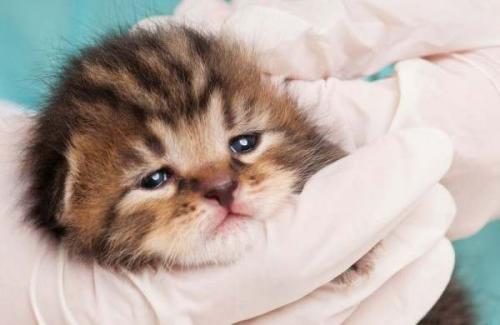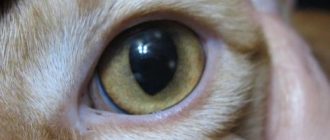The distemper of cats, or panleukopenia, is very contagious and life-threatening animal viral disease. Mortality young, unvaccinated kittens from the plague virus is at least 90%. This virus infects rapidly dividing blood cells in the body, in first of all, cells of the gastrointestinal tract, bone marrow and stem cells of a developing fetus. Because first of all blood cells are affected, this virus can lead to a condition anemia, and can also reduce the body’s immunity to infections and other diseases – both viral and bacterial.

Plague in unvaccinated cats is the most dangerous. Plague virus very viable and can live in polluted environments for many years, so vaccination is the best preventative means. Kittens aged two to six months are in the group at highest risk of developing dangerous symptoms diseases. Pregnant cats are also vulnerable to the virus. animals with a weakened immune system.
In adult cats, plague is usually mild and may even go unnoticed. Fortunately cats that survive after infection, acquire immunity to the virus.
It is important to note that even the cat distemper virus is caused parvovirus from the same group as dog parvovirus, these viruses do not connected. In addition, the distemper of cats is in no way connected with the distemper. dogs.
Symptoms of the plague
Contents
The disease is preceded by an incubation period of the virus, lasting from 2 to 10 days. Then the cat has the first clinical symptoms, the most common of which are the following:
- Vomiting
- Diarrhea, bloody diarrhea
- Complete loss of interest in food
- Dehydration
- Weight loss
- Heat
- Depression and lethargy
- Anemia (due to a decrease in the number of red blood cells in the blood)
- A sharp change in behavior, some cats can hide on one or two days.
- A cat sits above a bowl of water or food, but does not drink or eat (This is due to dehydration and pain in the digestive tract).
- The cat lies on its stomach, stretching its limbs, for a long period of time.
- The cat sits with its paws hidden under the body for a long period of time.
- Neurological symptoms, such as absence coordination.
- If the cat has an acute form of plague, it usually fatal. The acute form runs from 1 to 10 days and is accompanied by a sharp increase in temperature.
Causes of plague in cats
The cause of cat distemper is feline parvovirus (FPV). Cats may become infected with this virus through contact with an infected person. blood, feces, urine, or fleas that were previously on infected animal. The virus can also be transmitted through humans, if he has not washed his hands properly after contact with another a cat. In addition, the plague can be transmitted through any objects, that were used by other cats.
This virus can live on many surfaces, so for Prevention is important to observe hygiene measures. However, even in in the cleanest conditions, traces of the virus can still remain in the environment where the infected cat was. Feline parvovirus resistant to many disinfectants and may remain in the environment Wednesday up to a year.
Kittens can become infected through prenatal infection or through breast milk if the pregnant or lactating cat was infected. Predictions for kittens that have been infected in utero, as a rule, not favorable.
The highest risk of infection is in the summer months, as many cats go outside and come in contact with other cats. Similarly, shelters and nurseries can be sources of the virus, increasing the risk for your cat if you leave her in the nursery for the time of departure.
Plague diagnosis
You will need to provide your veterinarian with a complete health history. your cat and her last activity. If the cat has recently entered in contact with other cats, or if she is allowed to leave the house, then this may be important information for the veterinarian.
Plague can disguise many other diseases, including for poisoning, cat leukemia, cat immunodeficiency, pancreatitis and others. Therefore, it is important to give the veterinarian as detailed as possible information so that he can prescribe appropriate treatment immediately.
After the doctor has studied the story, he will perform a thorough physical examination and conduct several laboratory tests, including analysis of blood, feces and urine. A blood test, in case of a plague, will show decrease in the number of white and red blood cells. Fecal analysis can also detect microscopic remnants of parvovirus.
Virus treatment
Plague-affected cats require immediate treatment that may be symptomatic and specific. Dehydration is the main symptom of the plague, and this problem must be solved immediately using subcutaneous or intravenous infusion of solutions. The main goal is to restore fluid levels and electrolyte balance in the body. And since the virus infects the immune system, the veterinarian can prescribe to the animal preventative antibiotics to prevent secondary infections.
Providing timely symptomatic treatment may mean the difference between life and death. Your cat will need a long rest while she is in danger. It is important to provide her calm and warm space where it will be separated from children and other animals. Also place food and water bowls next to it, and a tray for the toilet, which will allow her not to waste extra energy on physical activity.
You will need to isolate the cat from other cats. Nonetheless, do not avoid physical contact with the cat, its chances of recovery also depends on your affection. Cat distemper virus has depressing effect on physical and psychological health animal. Also keep in mind that strict rules are important. hygiene, and always wash your hands after interacting with a cat, otherwise you you may inadvertently become a spreading virus.
If your cat receives timely and effective treatment in during the first two days (48 hours), it is likely that she fully recover and receive immunity to the virus for the whole remaining life. For full recovery, the cat may it takes up to several weeks for her to be able to return to his normal life. In addition, after recovery, the cat is already will not spread the virus.
Prevention after infection
Follow your veterinarian dosage recommendations medicines, rules for household disinfection and, when necessary, quarantine. If you have other cats, then you need to monitor them for symptoms of the disease. Consult with the veterinarian about the possibility of vaccinating other cats in the house.
Household bleach can be used as disinfectant against this virus but the best way make sure home is safe – remove all your cat’s things and replace them with new ones. It could be bedding, toys, dishes and trays. Again, keep in mind that even in this In case you cannot remove all traces of the virus. Of course your porridge will no longer be subject to re-infection after recovery, but other cats visiting your house may still be infected.
Vaccination is the most important prevention tool. this disease. Before you get a cat, do not forget ask the veterinarian to include the plague vaccine in the course vaccination. Unvaccinated pregnant cats along with kittens are in the group most vulnerable to the virus. Developing embryos also likely to be born with severe developmental dysfunctions.
Frequently asked questions about cat distemper
What are the first signs and symptoms of a plague?
The first signs of plague in cats are a sharp change behavior, lack of appetite, fever and onset vomiting Other symptoms may include diarrhea, lethargy, depression and lack of coordination.
How do cats get infected with plague?
The virus is transmitted between animals directly or indirectly, through direct contact with the blood, urine or saliva of an infected person animal. Common foods and utensils may also be ways to transmit the virus.
Is plague of cats transmitted to humans?
No, cat distemper is a viral disease that affects cats, it is not dangerous for humans, dogs and other domestic animals.
How is plague diagnosed?
Plague of cats is diagnosed, as a rule, by characteristic symptoms, medical history, and blood, urine, or stool tests.
Which cats are most vulnerable to the plague?
Unvaccinated kittens and unvaccinated pregnant cats are most vulnerable to the virus.
How to treat plague in a cat?
The cat will need intensive complex treatment, which can to be both symptomatic and specific. The animal can require intravenous infusions and antibiotics to prevent dehydration and secondary infections.






